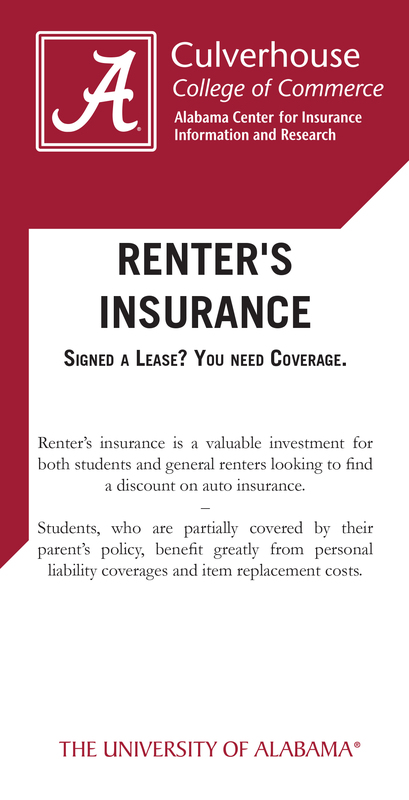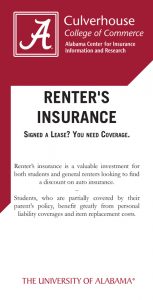
ACIIR Releases Renter’s Insurance Guide
- January 18th, 2018
- in Uncategorized
 TUSCALOOSA, Ala. –Retail sales are up from last year, and that means renters have more household items to protect. The Property Casualty Insurers Association of America (PCI) recommends renters add a review of their existing insurance coverage to their financial to-do list.
TUSCALOOSA, Ala. –Retail sales are up from last year, and that means renters have more household items to protect. The Property Casualty Insurers Association of America (PCI) recommends renters add a review of their existing insurance coverage to their financial to-do list.
The Alabama Center for Insurance Information at The University of Alabama Culverhouse College of Commerce has partnered with the Property Casualty Insurers Association of America, to produce the online interactive Renters Insurance Guide and a printable brochure highlighting the importance of purchasing renter’s insurance.
“A renter’s insurance policy can provide a safety net in the event of an accident to help cover the cost of replacing personal items as well as accidental injury coverage for guests staying at the insured property,” said Lars Powell, director of the Alabama Center for Insurance Information.
“This is the perfect time to get your financial house in order, and an evaluation of your insurance policies should always be part of that effort,” says Chris Hackett, senior director of personal lines policy for PCI. “Updating your insurance policies can give you the peace of mind that comes with knowing you’re properly covered for any unexpected events that may occur in the new year.”
“A renter’s insurance policy gives parents, students, workers, and empty-nesters peace of mind that their personal possessions are covered and will be replaced should an unforeseen event like a fire or theft happen,” said Hackett.
It is in everyone’s best interest to have renter’s coverage and talking with your insurer or agent is a great first step. The average consumer spends $1,092 on coffee each year. However, a renter’s insurance policy on average costs $240 per year.
A typical homeowners insurance policy will provide 10 percent of the personal property coverage limit for items kept away from home such as in a dorm. On the other hand, renter’s insurance also covers the items that students typically take with them to an off-campus apartment.
However, renter’s insurance also provides other important protection such as Additional Living Expense (ALE) coverage to help with expenses should the apartment become uninhabitable due to a covered loss such as a fire. Liability coverage can protect you if a guest injures themselves while visiting your apartment. It’s always good advice to read over your policy to understand what is, and what is not covered.
Renters insurance is affordable and can frequently be bundled with auto insurance to help keep costs low. Don’t make the mistake of thinking the landlord’s insurance will replace the tenant’s personal possessions. A landlord’s policy will only cover structural damage to the building from fire or wind. The personal belongings of a tenant are not covered under a landlord’s policy.
“As students head back to school with new laptops, tablets, printers, mobile devices, bicycles, stereo equipment, televisions and hard to replace items, it is important to consider protecting them from theft, fire, and accidental loss,” added Powell.
The Online Interactive Renters guide is available here: http://viewer.zmags.com/publication/780a0222#/780a0222/1
For more information, visit www.aciir.culverhouse.ua.edu orwww.pciaa.net
The Alabama Center for Insurance Information and Research provides credible information and research insight for the benefit key stakeholders across the state of Alabama, including policymakers, the public, insurance companies, intermediaries, trade groups, and other parties who need information concerning the management risk. ACIIR is dedicated to providing facts and truths to parties who directly contribute to the economic development of Alabama.
PCI is composed of nearly 1,000 member companies, representing the broadest cross-section of insurers of any national trade association. PCI members write $216 billion in annual premium, 36 percent of the nation’s property casualty insurance. Member companies write 43 percent of the U.S. automobile insurance market, 29 percent of the homeowners market, 34 percent of the commercial property and liability market and 36 percent of the private workers compensation market.
